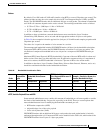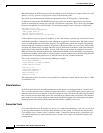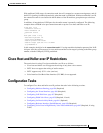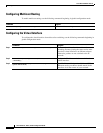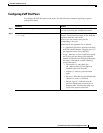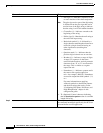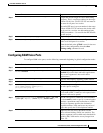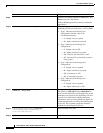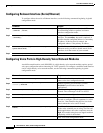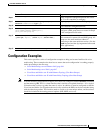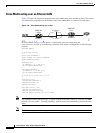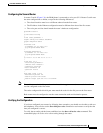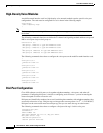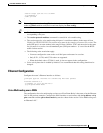
Cisco Hoot and Holler over IP
Configuration Tasks
VC-840
Cisco IOS Voice, Video, and Fax Configuration Guide
Step 9
Router(config-voice-port)# operation {2-wire | 4-wire}
Specifies the cabling scheme for E&M ports. The
2-wire keyword is the default.
(Choose 4-wire operation for the hoot and holler
application.)
Step 10
Router(config-voice-port)# type {1 | 2 | 3 | 5}
Selects the appropriate E&M interface type
(depending on the end connection—such as PBX):
• Type 1 indicates the following lead
configuration (default—this is the
recommended option):
–
E—Output, relay to ground
–
M—Input, referenced to ground
• Type 2 indicates the following lead
configuration:
–
E—Output, relay to SG
–
M—Input, referenced to ground
–
SB—Feed for M, connected to -48V
–
SG—Return for E, galvanically isolated
from ground
• Type 3 indicates the following lead
configuration:
–
E—Output, relay to ground
–
M—Input, referenced to ground
–
SB—Connected to -48V
–
SG—Connected to ground
• Type 5 indicates the following lead
configuration:
–
E—Output, relay to ground
–
M—Input, referenced to -48V
Step 11
Router(config-voice-port)# signal {wink-start |
immediate | delay-dial}
Configures the signaling type for E&M voice ports.
The default is wink-start. Select immediate for
the Cisco hoot and holler over IP application. In the
immediate-start protocol, the originating side does
not wait for a wink before sending addressing
information. After receiving addressing digits, the
terminating side then goes off-hook for the duration
of the call. The originating endpoint maintains
off-hook for the duration of the call.
Step 12
Router(config-voice-port)# voice-port
{slot-number/subunit-number/port} |
{slot/port:ds0-group-no}
Selects another voice port.
Step 13
Router(config-voice-port)# voice-class permanent tag
Uses the voice class tag for the receive-only port.
Command Purpose




